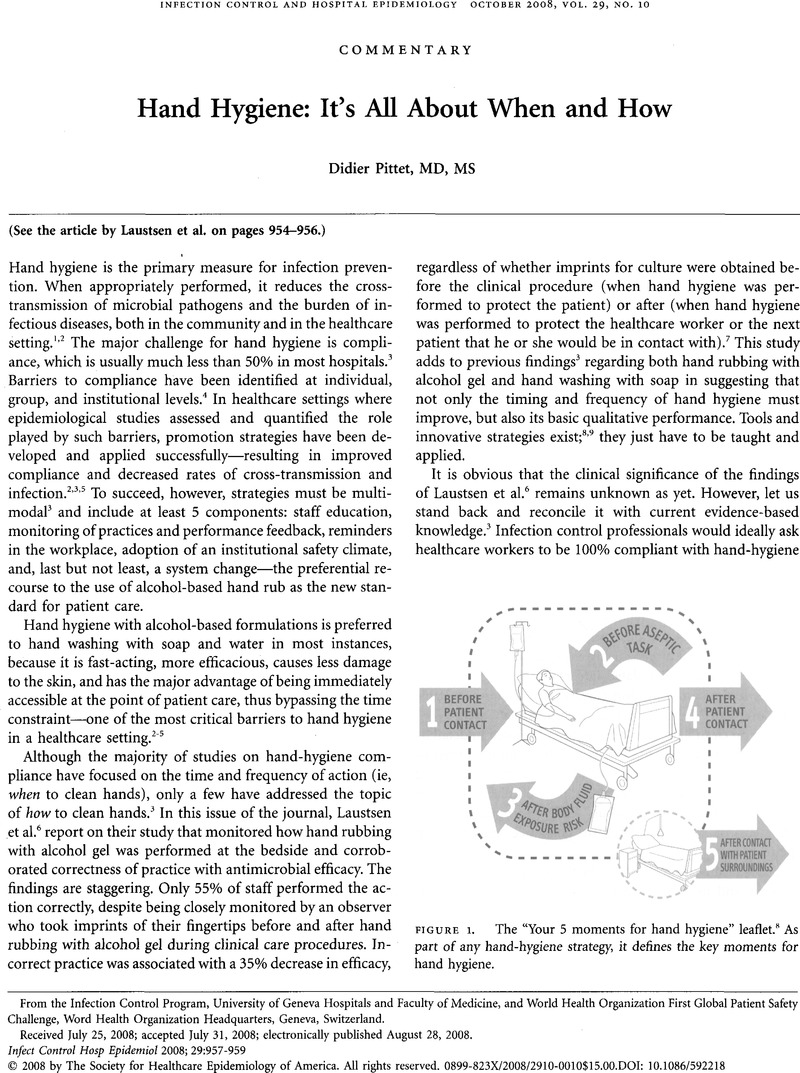Crossref Citations
This article has been cited by the following publications. This list is generated based on data provided by Crossref.
Eveillard, M.
Hitoto, H.
Raymond, F.
Kouatchet, A.
Dubé, L.
Guilloteau, V.
Pradelle, M.-T.
Brunel, P.
Mercat, A.
and
Joly-Guillou, M.-L.
2009.
Measurement and interpretation of hand hygiene compliance rates: importance of monitoring entire care episodes.
Journal of Hospital Infection,
Vol. 72,
Issue. 3,
p.
211.
Gillespie, Elizabeth
Kotsanas, Despina
Wilson, Jill
Buist, Michael
and
Stuart, Rhonda
2009.
Hand profiling: A novel tool used to demonstrate hand hygiene technique.
Healthcare infection,
Vol. 14,
Issue. 4,
p.
153.
Apisarnthanarak, Anucha
Thongphubeth, Kanokporn
Yuekyen, Chananart
Warren, David K.
and
Fraser, Victoria J.
2010.
Effectiveness of a catheter-associated bloodstream infection bundle in a Thai tertiary care center: A 3-year study.
American Journal of Infection Control,
Vol. 38,
Issue. 6,
p.
449.
Pittet, D.
Panesar, S.S.
Wilson, K.
Longtin, Y.
Morris, T.
Allan, V.
Storr, J.
Cleary, K.
and
Donaldson, L.
2011.
Involving the patient to ask about hospital hand hygiene: a National Patient Safety Agency feasibility study.
Journal of Hospital Infection,
Vol. 77,
Issue. 4,
p.
299.
Bellaard-Smith, Elizabeth Reika
and
Gillespie, Elizabeth E.
2012.
Implementing hand hygiene strategies in the operating suite.
Healthcare infection,
Vol. 17,
Issue. 1,
p.
33.
Rini, M.S.
Gatti, M.
and
Raitano, A.
2012.
Trattamento igienico delle mani per il controllo delle infezioni.
Prevenzione & Assistenza Dentale,
Vol. 38,
Issue. 2,
p.
43.
Mahfouz, Ahmed A.
El Gamal, Mohammad N.
and
Al-Azraqi, Tarik A.
2013.
Hand hygiene non-compliance among intensive care unit health care workers in Aseer Central Hospital, south-western Saudi Arabia.
International Journal of Infectious Diseases,
Vol. 17,
Issue. 9,
p.
e729.
Scheithauer, S.
and
Lemmen, S.W.
2013.
How can compliance with hand hygiene be improved in specialized areas of a university hospital?.
Journal of Hospital Infection,
Vol. 83,
Issue. ,
p.
S17.
Prado, Maria Fernanda do
Hartmann, Talita Priscila Scomparin
and
Teixeira Filho, Leône Alberto
2013.
Acessibilidade da estrutura física hospitalar para a prática da higienização das mãos.
Escola Anna Nery,
Vol. 17,
Issue. 2,
p.
220.
Mahfouz, Ahmed A.
Al-Zaydani, Ibrahim A.
Abdelaziz, Ali O.
El-Gamal, Mohammad N.
and
Assiri, Abdullah M.
2014.
Changes in hand hygiene compliance after a multimodal intervention among health-care workers from intensive care units in Southwestern Saudi Arabia.
Journal of Epidemiology and Global Health,
Vol. 4,
Issue. 4,
p.
315.
Choi, Eun Hee
Jang, In Sun
and
Choi, Ji Youn
2014.
The Effect of an Educational Hand Washing Program on Knowledge, Attitude and Performance of Hand Washing in Undergraduates.
Journal of the Korean Society of School Health,
Vol. 27,
Issue. 1,
p.
39.
Al Salman, J.M.
Hani, S.
de Marcellis-Warin, N.
and
Fatima Isa, Sister
2015.
Effectiveness of an electronic hand hygiene monitoring system on healthcare workers’ compliance to guidelines.
Journal of Infection and Public Health,
Vol. 8,
Issue. 2,
p.
117.
Price, Lesley
Roome, Karen
Lisa, Ritchie
Reilly, Jacqui
McIntyre, Jackie
Godwin, Jon
and
Bunyan, Donald
2016.
Toward improving the World Health Organization fifth moment for hand hygiene in the prevention of cross-infection.
American Journal of Infection Control,
Vol. 44,
Issue. 6,
p.
631.
Bellissimo-Rodrigues, Fernando
Soule, Hervé
Gayet-Ageron, Angèle
Martin, Yves
and
Pittet, Didier
2016.
Should Alcohol-Based Handrub Use Be Customized to Healthcare Workers’ Hand Size?.
Infection Control & Hospital Epidemiology,
Vol. 37,
Issue. 2,
p.
219.
Kramer, Axel
Pittet, Didier
Klasinc, Romana
Krebs, Stefan
Koburger, Torsten
Fusch, Christoph
and
Assadian, Ojan
2017.
Shortening the Application Time of Alcohol-Based Hand Rubs to 15 Seconds May Improve the Frequency of Hand Antisepsis Actions in a Neonatal Intensive Care Unit.
Infection Control & Hospital Epidemiology,
Vol. 38,
Issue. 12,
p.
1430.
Pires, Daniela
Soule, Hervé
Bellissimo-Rodrigues, Fernando
Gayet-Ageron, Angèle
and
Pittet, Didier
2017.
Hand Hygiene With Alcohol-Based Hand Rub: How Long Is Long Enough?.
Infection Control & Hospital Epidemiology,
Vol. 38,
Issue. 5,
p.
547.
Pires, Daniela
Bellissimo-Rodrigues, Fernando
Soule, Hervé
Gayet-Ageron, Angèle
and
Pittet, Didier
2017.
Revisiting the WHO “How to Handrub” Hand Hygiene Technique: Fingertips First?.
Infection Control & Hospital Epidemiology,
Vol. 38,
Issue. 2,
p.
230.
Rigby, Ruth
Pegram, Anne
and
Woodward, Sue
2017.
Hand decontamination in clinical practice: a review of the evidence.
British Journal of Nursing,
Vol. 26,
Issue. 8,
p.
448.
Price, Lesley
Melone, Lynn
McLarnon, Nichola
Bunyan, Donald
Kilpatrick, Claire
Flowers, Paul
and
Reilly, Jacqueline
2018.
A systematic review to evaluate the evidence base for the World Health Organization's adopted hand hygiene technique for reducing the microbial load on the hands of healthcare workers.
American Journal of Infection Control,
Vol. 46,
Issue. 7,
p.
814.
Peters, Alexandra
Otter, Jon
Moldovan, Andreea
Parneix, Pierre
Voss, Andreas
and
Pittet, Didier
2018.
Keeping hospitals clean and safe without breaking the bank; summary of the Healthcare Cleaning Forum 2018.
Antimicrobial Resistance & Infection Control,
Vol. 7,
Issue. 1,



